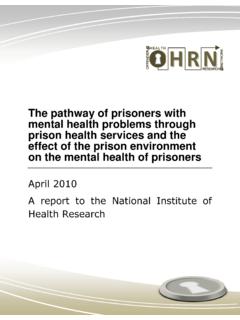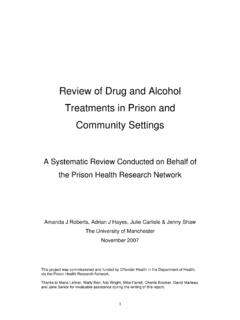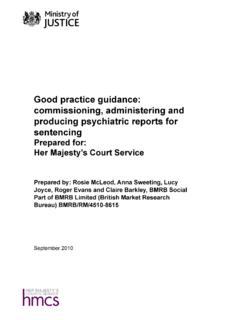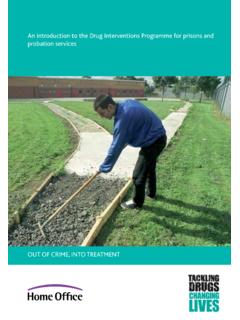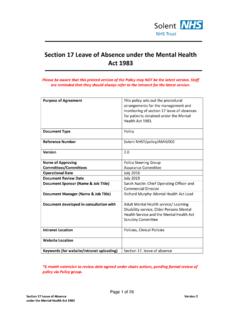Transcription of 40 Removing barriers - Offender Health Research …
1 BRIEFINGS ummaryThis briefing paper looks at the barriers to employment for people with both common and severe mental Health problems and at the initiatives that are being undertaken by the public, voluntary and commercial sectors to support their efforts to find and sustain work. Too often people with common mental Health problems, such as anxiety and depression, lose their jobs when they become unwell. Every day, opportunities to support people in work to get appropriate treatment and maintain their employment are being missed in workplaces across the UK. British business could save up to 8 billion a year if it managed mental Health at work more effectively. People with severe and enduring mental Health problems, such as schizophrenia and bi-polar disorder (manic depression), are less likely to be employed than any other group of disabled people. Yet the vast majority want to work and Research shows that many people have and can be supported to secure and maintain paid competitive employment through Individual Placement and Support (IPS).
2 The Government s welfare reform agenda emphasises the importance of getting more people with disabilities into employment. There are legitimate concerns that too much emphasis is being placed on getting people off welfare benefits as an end in itself. But the risks of doing nothing, especially during a recession, are greater still. In the last recession, many people with mental Health problems were written off as unemployable. We must ensure that we offer people the right help at the right time, or we run the risk of creating a new lost generation . c40: Removing barriersThe facts about mental Health and employment2 Sainsbury Centre for mental Health BRIEFING 40 Removing BarriersStigma and discrimination in the workplacePeople with mental ill Health face stigma and discrimination when trying to find work or retain their jobs. Many people in employment feel isolated and ostracised by colleagues who do not know how to support them (Thornicroft, 2006).
3 A recent study found that almost half (45%) of people with physical Health problems experienced mild to moderate depression, but were more worried about telling their employer about their mental Health issues than about their cancer or heart disease (Loughborough University / mental Health Foundation, 2009). Around a half (52%) of UK organisations say they have never knowingly recruited anyone with a history of mental ill Health (CIPD, 2007). In a survey of public attitudes only two-thirds of people agreed that People with mental Health problems should have the same right to a job as anyone else (TNS Global, 2007). Employers have legal duties under the Disability Discrimination Act (1995) not to discriminate against disabled employees and job applicants, including people whose mental Health problems result in them being disabled. It places a duty on employers and service providers to make reasonable adjustments to enable disabled people to work and access services.
4 However, there are limits to the power of legislation to change attitudes and we need to understand much more about employers requirements and fears if we are to improve recruitment of people with a history of mental ill Health . Low expectations and a lack of resources Low expectations by Health care staff (Marwaha et al., 2009) can also hinder a person s return to work. Staff may focus on maintenance of treatment rather than on recovery and a return to an independent life. Only half of mental Health service users in contact with specialist mental Health services report having received any help with employment (Healthcare Commission, 2008). Poor communication between Health and employment services can also create a barrier. For many people, the journey to unemployment begins with the issuing of a sick note by their family doctor. GPs often issue sickness certificates without discussion of other options. Introduction At any one time one worker in six will be experiencing depression, anxiety or problems relating to stress (Singleton et al.)
5 , 2001). Many people find it difficult to remain in employment and face isolation and discrimination in their workplaces. They are at double the risk of losing their jobs compared with those who do not have a mental Health problem (SEU, 2004). Over 200,000 people with mental Health problems start claiming incapacity benefits each year (Black, 2008). But many people could remain in work with support from their GPs and their proportion of people claiming Incapacity Benefit for mental Health problems rose from 26% to 41% between 1996 and 2006. Many claimants with physical Health problems also experience mental ill Health . Around 70% of claimants in an analysis of Incapacity Benefit medical examinations had some form of mental Health problem (Black, 2008). People who experience severe and enduring mental Health problems have one of the lowest employment rates. Only one user in five of specialist mental Health services either has paid work or is in full-time education (Healthcare Commission, 2008).
6 Yet many are able to work and pursue careers, if properly supported, and a person s diagnosis is often a poor predictor of employability (Grove & Membrey, 2005). Research shows that work is good for our physical and mental Health (Waddell & Burton, 2006). While unemployment can damage Health and lead to a range of social problems such as debt and social isolation, being in employment and maintaining social contacts improves mental Health , prevents suicide and reduces reliance on Health services (SEU, 2004; Black, 2008). barriers to employmentThe following section sets out some of the key barriers to employment for people with mental Health problems. 3 Sainsbury Centre for mental Health BRIEFING 40 Removing BarriersResearch shows high levels of variability between different GPs, with some judging whether to sign someone off work based not just on their capacity to work but on their age, attitude and presumed job prospects (SEU, 2004).A survey of 1,500 GPs has found that two-thirds (64%) were unaware of the evidence that work is beneficial for physical and mental Health .
7 Most said that, if they knew of this evidence, it would affect the advice they give (DWP, 2007).Psychological therapies such as cognitive behavioural therapy (CBT) can play a role in helping people to remain in work (Seymour & Grove, 2005). In 2006 some 59% of GPs said that local access to CBT was poor and many admitted to prescribing antidepressant medications because they could not access talking therapies (Hairon, 2006). The roll out of the Department of Health s Improving Access to Psychological Therapies (IAPT) programme has led to significant improvements but there are still reports of long waiting lists in some areas and it is vital that the programme is sustained until it covers the whole of England. It is estimated that only 3% of companies have a comprehensive occupational Health (OH) service. Few OH workers have an understanding of mental Health issues and few mental Health workers have direct experience of OH. Small and medium sized businesses often have no OH support (RCP, 2008).
8 The Government plans to address this by introducing an OH telephone helpline to support smaller businesses (DH / DWP, 2008). Financial disincentives Incapacity benefits were originally introduced to provide additional support for those unable to work due to long-term ill Health . But the system created financial disincentives for anyone wishing to return to work. Many feared that they would lose their entitlement to benefits before they could cope with an ordinary job. The Welfare Reform Act and forthcoming changes to housing and council tax benefits aim to remove these disincentives, but the fear still remains for people with recurring ill Health that a return to work will leave them worse off. Government policy Government policy has focused on tackling all forms of social exclusion (SEU, 2004; Social Exclusion Task Force, 2006). Dame Carol Black s review of Health and work (Black, 2008; DH / DWP, 2008), the forthcoming mental Health and employment strategy, and the review of employment services for people with severe and enduring mental Health problems led by Dr Rachel Perkins, emphasise the Government s goal of enabling more people with mental Health problems to gain and retain service agreementsPublic service agreement (PSA) targets have been introduced to measure the performance of the public sector in meeting the government s key goals.
9 PSA 16 focuses on social inclusion and includes a new set of targets (known as National Indicator 150) for local authorities and their partners to report annually on the numbers of people in contact with specialist mental Health services who are in paid employment (DCLG, 2007).Welfare Reform Act The 2007 Welfare Reform Act radically changed the incapacity benefits system. It introduced the Employment and Support Allowance (ESA) from October 2008 to replace Incapacity Benefit (IB) for new claimants. During the first thirteen weeks of a new ESA claim, all claimants are asked to go through a work capability assessment. After this, those who are considered able to work must then take part in work-related activities, otherwise their benefits will be sanctioned. People with more disabling conditions who are not considered able to work will be entitled to a higher level of financial support which will not be conditional on any activity. They can, however, opt to work and will then be entitled to the same level of vocational support as the first group.
10 Between April 2009 and 2013 all people whose claims began before October 2008 are being transferred onto ESA. From April 2010 they will also be required to undergo a work capability assessment. Further changes being debated in Parliament at the time of going to press will increase the use of conditionality in the benefit system. Sainsbury Centre remains concerned 4 Sainsbury Centre for mental Health BRIEFING 40 Removing Barriersthat the use or threat of benefit sanctions will be counter-productive among people with mental Health problems and that people who need the most support to get paid work will not be adequately assisted in the reformed to Work The Pathways to Work scheme (see Box 1) offers a range of support for benefit claimants seeking work. Despite initial concerns that its advisors lacked training and experience in working with people with mental Health problems, Research by the DWP shows that the programme, as originally delivered by Jobcentre Plus and the NHS, has been as effective for this group of people as for any other (Bewley et al.)
